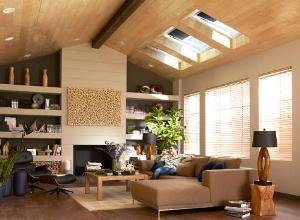Apr 23 2014
Earth Day is a perfect time for homeowners looking for a green method to bring more natural light and passive ventilation into homes to consider solar powered fresh air skylights. Homes that utilize skylights, in combination with vertical windows, to provide adequate levels of daylight tend to be more energy efficient, according to a study commissioned by VELUX America.
 Energy Star-qualified solar powered fresh air skylights, with decor-enhancing solar powered designer blinds, add drama to any room while providing abundant natural light, passive ventilation and privacy. Both skylights and blinds are operated by remote control and are eligible for a 30 percent Federal tax credit, as are installation costs. (PRNewsFoto/VELUX)
Energy Star-qualified solar powered fresh air skylights, with decor-enhancing solar powered designer blinds, add drama to any room while providing abundant natural light, passive ventilation and privacy. Both skylights and blinds are operated by remote control and are eligible for a 30 percent Federal tax credit, as are installation costs. (PRNewsFoto/VELUX)
An in-depth discussion of the study is found at http://tinyurl.com/admhwh4 while a more consumer-oriented site illustrating skylight features and benefits is at www.whyskylights.com.
"A Study of the Energy Impacts of Residential Skylights in Different Climates," prepared by Group14 Engineering, used computer models based on a one-story, open plan, single-family home modeled under code-compliant conditions of California's Title 24 regulations. The baseline-modeled home has a maximum 20 percent window-to-floor area (with no skylights) with windows evenly distributed on all facades to achieve an average daylight factor of five percent.
Researchers added skylights and adjusted the amount and configuration of vertical windows to test how the model would perform in different climate zones, while giving the living space sufficient daylight. The study explored the effects of these configurations on the utility bills generated by the model homes in Los Angeles and Napa, California, Boston, Chicago, Denver, Dallas, Minneapolis, Orlando and Seattle, using their specific code requirements.
It found that by providing daylight via skylights, the total glazing area could be reduced, on average, from a maximum 20 percent of floor area to 12 percent of floor area while achieving the same baseline average of daylight factor target of five percent. In the best-case scenario, the total glazing area was reduced from 20 percent to as low as eight percent.
This was found to reduce annual heating and cooling energy use and costs in all but two of the 108 models with skylights the group analyzed. For simplicity, lighting savings, shading efficiencies, and increased natural ventilation attributable to skylights were not evaluated. Further studies are underway to quantify these additional efficiency contributions.
"While we have always known the intangible benefits of adding daylighting from above to homes, this study provides empirical evidence that natural light from skylights can contribute to the home's overall energy efficiency," said Stephan Moyon, direct of sales for VELUX America. "Skylights admit twice as much daylight per square foot of glass as vertical windows," Moyon says. "This provides a rational explanation as to why adding skylights can help reduce glazing while maintaining the daylight factor."
Group14 Engineering is based in Denver, Colorado. The company specializes in energy modeling, daylighting and LEED strategy for architectural firms and building owners.
VELUX America is an ENERGY STAR® partner and has been recognized as a Partner of the Year. For more, visit www.veluxusa.com or call 1-800-283-2831.